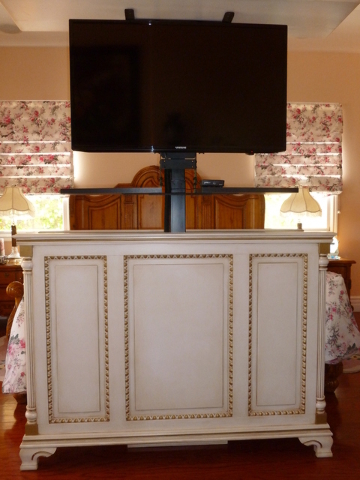Up/down cabinets conceal slim TVs
On a bright and sunny morning, in a home high up in the Spring Mountains, another TV armoire recently met its demise. In a world obsessed with slim everything — slim telephones, slim-cut jeans, slim physiques — the armoire’s end was only a matter of time. And it had held on longer than most.
Like many armoires before it, this once proud cabinet had housed man’s second best friend, the television. But the armoire was relegated to the lowly status of a repository for household items best kept out of sight. It was a victim of technology and the relentless pursuit of design excellence and viewing comfort.
Ever since its introduction more than 30 years ago, the up/down TV cabinet has had, in my opinion, equal appeal for both men and women. And it still does.
The men with their natural proclivity for gadgets with motors and remote controls embraced the idea enthusiastically. The women fell in love with it because it was so much prettier than an exposed black box, thus appealing to their feminine aesthetic.
And because the up/down TV cabinet’s styles and finishes could satisfy even the most discriminating people, it was a winner from day one.
Given the basic premise that a cabinet is ideally built “from the inside out” (meaning that its contents will determine the size: height, width, depth, etc.), we have come a long way from the earliest efforts to conceal a TV. Current design now allows for one very slim-looking cabinet.
Television sets of old could be 24 to 36 inches deep. New models sport a slimmed-down depth of mere inches, enabling a host of new display and concealment possibilities.
So, it’s been adios for a while to the once obligatory and ubiquitous armoire for hiding that nasty black screen, and hello to “Mr. Slim” now so proudly displayed for all to see on the wall or over the fireplace, or hidden in a narrow cabinet, which serves to underscore his new, ultrasvelte physique.
A while back, I was an original proponents of the up/down cabinet for TV concealment and introduced the concept of hiding the TV inside a cabinet that might look like an oval pedestal or a bar or even a chest of drawers, when in a closed position. Designs have ranged from ornate French to exotic Moroccan and from classic Biedermeier to fabulous Asian and on and on.
The tricky “scissor” lift was the original mechanism that subsequently morphed into the far more reliable (and certainly quieter) rack-and-pinion models, and finally to the brilliant new lift mechanism that’s a cause for celebration.
You see, in the past, cabinet builders for up/down units had to construct an “inner box” that served as the housing and platform to which the mechanism would be attached. The TV would be placed on top of that platform, enabling the set to go up and down.
Great care had to be taken to balance the mechanism properly so that the TV wouldn’t wobble as it moved. And, the mechanism was noisy, but this was accepted as a necessary evil so long as it did its job.
Those concerns are now pretty much forgotten. Gone is the necessity of constructing an inner box and, along with it, the need to ensure that it’s properly balanced.
Gone, too, is the bothersome noise.
Today, the TV is attached to a track mounted directly to the back cabinet wall; it raises effortlessly and efficiently on that track, never wobbling or creating disturbing noise.
Mechanisms for lowering and raising are available, by the way, for so many more applications than just TV cabinets. These include units for ceilings, floors and walls and unique applications such as adapting an antique cabinet for TV display with a remote-controlled movable panel.
There’s even a mechanism that slides out from under a bed and raises the TV with the simple touch of a button.
There’s now a state-of-the-art mechanism for every possible need and application that is either premanufactured (standard) or customized. They feature near silent operation and guarantee a high degree of reliability and long-term satisfaction.
Today’s engineers have created an industry benchmark with the current crop of lift mechanisms, given their ease of installation and operational safety. One thing is certain, no matter how we choose to display or conceal the television, newer and ever more ingenious ways to see images on a screen are surely on their way.
Stephen Leon is a licensed interior designer and president of Soleil Design; he has been designing and manufacturing custom furniture and cabinetry for more than 25 years. He is past president of the Central California/Nevada Chapter of the American Society of Interior Designers and is a certified professional in green residential design. Questions can be sent to soleildesign@cox.net.


















